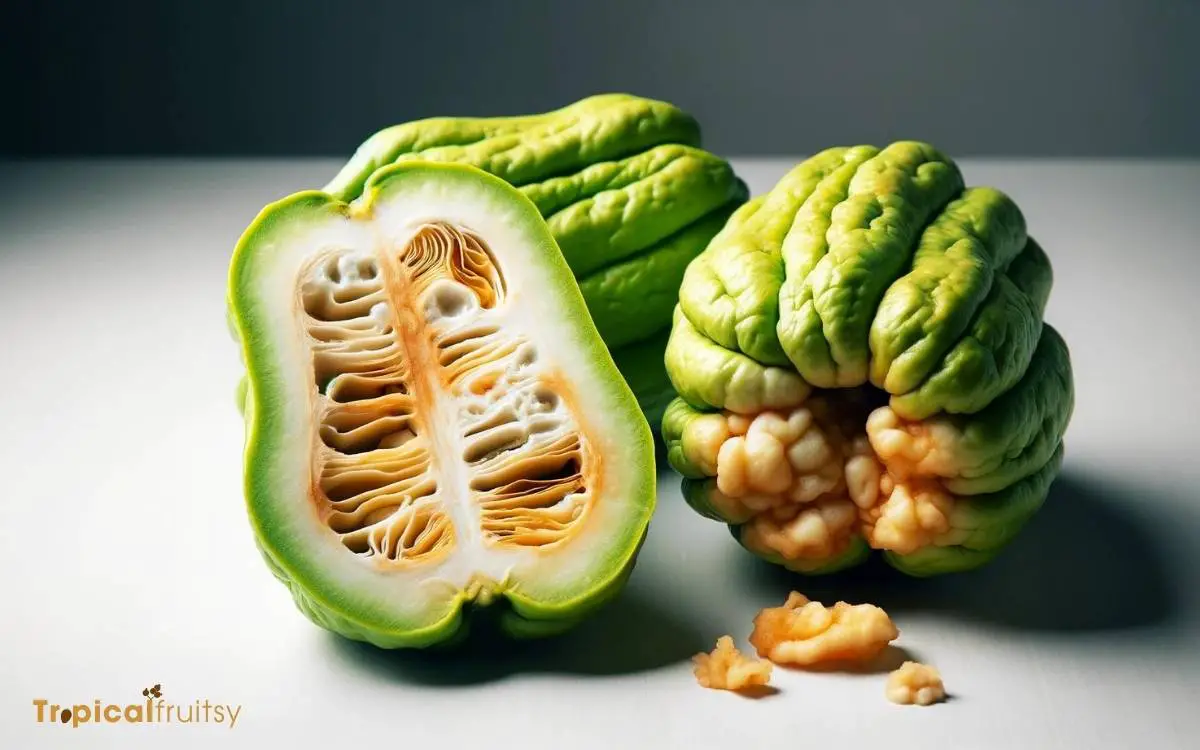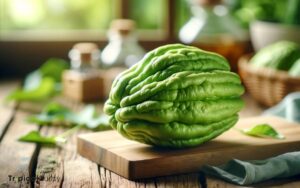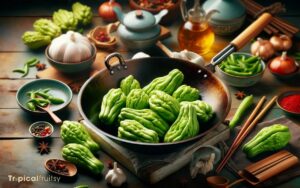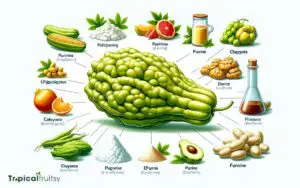How to Tell If Chayote Is Bad? 5 Easy Steps!
To determine if a chayote is bad, inspect for soft spots, mold growth, an off smell, and discoloration. Fresh chayote should be firm, have a green color, and be free from blemishes or mold.
Chayote spoilage can be identified through several clear signs:
Ensure the safety and flavor of your dishes by identifying and discarding spoiled chayote before use.

Key Takeaway
Step 1: Inspecting Chayote Skin
One can determine the freshness of chayote by carefully examining the condition of its skin. The skin should be firm and free of blemishes or soft spots. A high-quality chayote will display a bright green, unblemished skin that is smooth to the touch.
Over time, the skin may begin to show signs of aging, such as wrinkling or dullness. These signs can indicate moisture loss and potential internal decay.
Any appearance of brown spots or a spongy texture suggests that the chayote is past its prime and may harbor compromised flavor and nutritional value.
It is essential to apply a methodical approach when inspecting chayote. Evaluating its skin for uniformity in texture and color can provide a reliable indicator of its overall freshness and edibility.
Step 2: Checking for Soft Spots
Examining chayote for soft spots is a crucial step in assessing its freshness, as these areas often signify spoilage and inferior quality.
Soft spots are typically a result of enzymatic breakdown or microbial activity, which can compromise the vegetable’s texture and flavor.
Upon tactile inspection, a fresh chayote should feel firm throughout. If pressure reveals yielding areas, this indicates the initial stages of decay.
It is essential to apply gentle, consistent pressure to detect subtle variations in firmness, as overly aggressive handling can cause bruising and create false indicators of spoilage.
Analyzing the distribution and depth of soft spots provides insight into the extent of deterioration, guiding informed decisions regarding culinary use or disposal.
Step 3: Identifying Off-Odors
In addition to tactile assessment, detecting off-odors is a reliable method for determining the freshness of chayote, as a pungent or unpleasant smell often indicates spoilage.
Fresh chayote should have a subtly sweet or neutral scent, indicative of its crisp, edible state.
The presence of sour, fermented, or musty odors emanating from the chayote is a clear sign of decay, resulting from microbial activity that progresses as the vegetable deteriorates.
Scientific analysis of volatile organic compounds responsible for spoilage-related odors can confirm the presence of decay. This olfactory evaluation is critical, as it often precedes visible signs of spoilage, providing an early warning.
Next, we will transition to a visual examination, assessing the color, which can further substantiate the chayote’s condition.
Step 4: Assessing the Color
Assessing chayote’s color, a vibrant green hue typically signifies freshness, while discoloration such as browning or yellowing may indicate spoilage.
To provide a clear understanding, it is essential to observe the chayote’s surface thoroughly. Any signs of color alteration can often be an indication of age, improper storage, or the onset of decay.
The table below categorizes the color changes and their potential meanings:
| Color | Indication | Action |
|---|---|---|
| Vibrant Green | Fresh | Good for consumption |
| Yellowing | Ageing | Consume soon if no other signs of spoilage |
| Brown Spots | Beginning of Decay | Cut away spoiled parts if rest is firm |
The presence of brown spots does not always mean the chayote is entirely spoiled; however, it requires careful assessment of firmness and other spoilage signs to determine if the remaining flesh is edible.
Step 5: Recognizing Age-Related Issues
Regarding age-related issues in chayote, a gradual softening of the flesh typically precedes more visible signs of spoilage.
As the chayote matures beyond its prime, certain indicators become particularly noteworthy.
- Surface Wrinkling: Over time, a chayote’s skin may develop wrinkles, a telltale sign of dehydration and aging. This textural change suggests a diminishing water content, which impacts the vegetable’s crispness.
- Discoloration Patches: While slight browning can be normal, extensive discoloration often signals internal degradation. The appearance of dark spots or widespread color changes can indicate the onset of rot.
- Internal Cavity Formation: The development of hollow areas inside the chayote is a symptom of aging. These cavities, which can harbor bacterial growth, compromise the structural integrity and flavor profile of the vegetable.
Each of these aspects provides evidence of the chayote’s decline in freshness and edibility, underscoring the importance of timely consumption.
Conclusion
The integrity of chayote is paramount for culinary use and consumption. Vigilant inspection of the skin, attentiveness to textural changes, and olfactory analysis provide crucial insights into its edibility.
Discoloration serves as a visual cue signaling potential spoilage. As chayotes age, their susceptibility to degradation escalates.
Through systematic evaluation, one can determine the viability of the chayote, ensuring that only the freshest, most wholesome produce graces the table.






